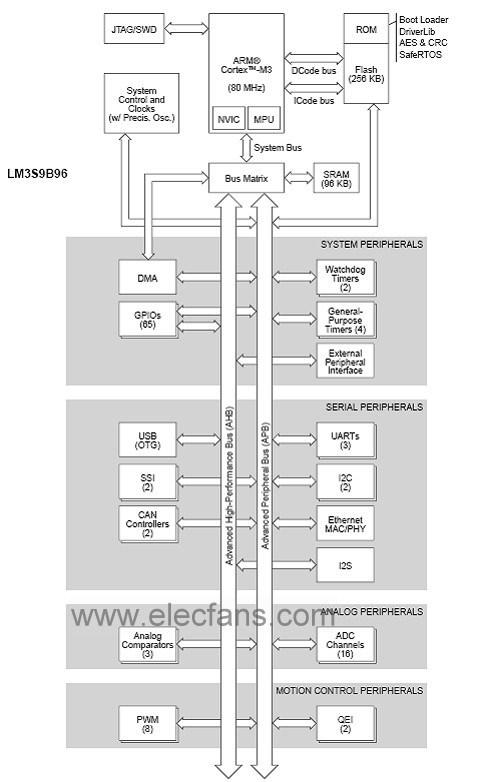Special CortexM3-1752開發(fā)套件說明Special CortexM3-1752開發(fā)套件,是格蘭瑞科技開發(fā)的工業(yè)級Cortex-M3系列套件之一�,具備豐富的例程和資源��,可以幫助
2011-04-18 17:19:44
單片機啟動方式首先上幾幅Cortex-M3內(nèi)核的參考手冊的圖:一般情況下我們用到的開發(fā)板��,例如帶一鍵下載功能的都是從系統(tǒng)存儲器開始啟動的。系統(tǒng)存儲器是一塊存儲空間,他里面的內(nèi)容就是Bootloader(程序)/啟動程序��,不管怎么理解反正它是一段程序即可��,不同廠家生產(chǎn)的芯片BootLoader程序可能
2021-12-10 07:26:13
雖然使用Cortex-M3的MCU有兩三幾年了��,但主要是基于c語言開發(fā),而且因為網(wǎng)絡(luò)上資源非常多�,官方提供的project也比較多��,導致并未對MCU的運行原理進行詳細的分析過。最近
2021-11-01 08:43:49
STM32單片機STM32的核心Cortex-M3處理器是一個標準化的微控制器結(jié)構(gòu)�,希望思考一下����,何為標準化�?簡言之�,Cortex-M3處理器擁有32位CPU,并行總線結(jié)構(gòu),嵌套中斷向量
2021-07-16 06:33:15
Cortex-M3處理器��,是市場上現(xiàn)有的最小�、能耗最低、最節(jié)能的ARM處理器。該處理能耗非常低、門數(shù)量少、代碼占用空間小����,使得MCU開發(fā)人員能夠以8位處理器的價位����,獲得32位處理器的性能����。超低門數(shù)還
2014-12-10 17:21:29
Cortex-M3技術(shù)參考手冊
2020-05-17 08:27:14
Cortex-M3權(quán)威指南
2019-08-17 21:04:16
Cortex-M3權(quán)威指南
2020-05-06 08:50:48
Cortex-M3權(quán)威指南
2013-06-17 08:25:22
Cortex-M3權(quán)威指南
2016-04-23 17:47:00
file:///Users/***/Desktop/Cortex-M3權(quán)威指南一.pdf
2015-04-30 14:20:40
低實時性好代碼密度得到很大改善使用更加方便低成本的整體解決方案開發(fā)工具眾多:keil、Cube…二者之間的關(guān)系上圖是基于Cortex-M3內(nèi)核的MCU��,Cortex-M3相當于一個小CPU(中央處理器)��。MCU就是我們看到的芯片��,不同芯片生產(chǎn)廠家在得到Cortex-M3內(nèi)核的使用授權(quán)之
2021-11-10 08:19:03
Cortex-M4比Cortex-M3多了哪些功能?
2021-10-22 08:27:27
各位前輩����,小弟差等本科畢業(yè)要做畢業(yè)設(shè)計��,基于Cortex-M3做一個web服務(wù)器,然后PC訪問。想要實現(xiàn)的內(nèi)容就是在Cortex-M3通過網(wǎng)絡(luò)傳送圖片給訪問的PC��,可是Cortex-M3沒有文件系統(tǒng)
2013-04-23 13:27:54
Cortex-M3 MCU如何走出差異化的8位單片機替代之路前陣子��,MCU市場“噩耗”頻頻傳出����。由于微控制器產(chǎn)品利潤的不斷下滑����,先是富士通半導體宣布出售其MCU業(yè)務(wù)�,緊接著三星半導體也不得不斷臂淡出
2019-07-19 06:26:18
文件較大����,分卷壓縮了����,請將三個壓縮包下載到同一目錄下解壓縮即可�。LM3S9B96中文數(shù)據(jù)手冊.part1
2019-09-03 11:46:59
在LM3S9B96的驅(qū)動函數(shù)庫文件sound.c中��,中斷處理函數(shù):voidSoundIntHandler(void)[ unsigned long ulStatus; unsigned long
2020-08-21 14:20:58
目前使用LM3S9B96-IQC89-C5調(diào)試,但注意到該芯片版本更新比較快,請問用在高可靠性要求的量產(chǎn)產(chǎn)品上,有何風險?假如x年后有新版本芯片能完全兼容嗎?另外能兼容LM3S9B96的性能最穩(wěn)定的是哪一款?
2019-09-02 13:23:42
跪求如何使用LM3S9B96微控制器控制液晶驅(qū)動芯片SSD1963來驅(qū)動4.3寸彩色TFT顯示屏注意�!本人沒有那個Stellaris驅(qū)動庫
2013-10-18 20:55:21
LM3S9B92的以太網(wǎng)控制器程序放到LM3S9B96中沒有響應(yīng)��,請問這兩片芯片的以太網(wǎng)控制器那個有區(qū)別沒有呢?
?
2018-05-14 06:10:52
cortex-m3/cortex-m4/cortex-a8的區(qū)別是什么�?
2021-10-22 06:54:10
本帖最后由 nwx8899 于 2012-10-7 23:48 編輯
cortex-m3實用教程
2012-07-26 01:46:20
cortex-m3軟件斷點/單步執(zhí)行的實現(xiàn)機制是什么?
2022-01-26 07:22:21
這是lm3s9b96的中文數(shù)據(jù)手冊
2012-05-16 12:38:51
STM32系列基于專為要求高性能��、低成本、低功耗的嵌入式應(yīng)用專門設(shè)計的ARM Cortex-M3內(nèi)核(ST's product portfolio contains a comprehensive
2021-08-05 06:15:05
的用戶的推動下�,一般應(yīng)用程序的復(fù)雜性正在增加接口����、多媒體需求��、系統(tǒng)速度和功能融合��。
ARM Cortex-M3處理器,Cortex第一代處理器發(fā)布ARM在2006年推出的微處理器主要是針對32位
2023-10-11 06:08:32
資料分享ARM Cortex-M3權(quán)威指南
2015-11-06 11:13:14
外部中斷一����、ARM Cortex-M3 的中斷體系二、代碼思路函數(shù)接口1.為引腳選擇使用哪個中斷2.配置外部中斷3.中斷優(yōu)先級配置4.獲取外部中斷狀態(tài)5.清空外部中斷標志位中斷優(yōu)先級1.概述2.搶占
2021-08-16 07:38:43
ARM Cortex-M3系統(tǒng)設(shè)計與實現(xiàn)——STM32基礎(chǔ)篇目錄0. 嵌入式入門學習路線1. STM32 MCU簡介 1.1 stm32 mcu結(jié)構(gòu) 1.2 STM32 MCU存儲器映像 1.3
2021-11-10 07:50:06
大家對ARM 的Cortex嵌入式處理器����,特別是Cortex-M 系列的處理器都會有所認識了�,所以到這一編Blog就和大家深入一點��,說一下Cortex-M3的開發(fā)板以及其一些應(yīng)用啦�! ARM 公司
2013-01-29 15:05:30
arm Cortex-m3到底可以做多快�?用過STM32F103到STM32F407,內(nèi)部也就100-200MHz左右��,見到有說做到300M的��,我沒有用過這個速度的片子����,用FPGA綜合出的速度就更慢了����。請教各位,Cortex-M3到底可以做多快�?受哪些因素影響��?
2022-10-26 16:06:08
各位,LM3S9B96開發(fā)板可以跑linux系統(tǒng)嗎��?可以的話推薦一塊比較適合初學者的開發(fā)板��。謝謝?���。��?�!
2013-11-10 17:11:11
最實用的開發(fā)工具����。下載速度高達800K/S��,支持ARM7/9/11/Cortex-M3����,并支持JTAG�、SWD兩種調(diào)試接口。IAR PowerPac RTOS和中間件家族 IAR PowerPac 家族包括
2014-04-17 10:48:18
ARM7����、ARM9、ARM11與ARM-Cortex有何關(guān)系?ARM7�、ARM9��、cortex-m3、cortex-m4與cortex-a8的區(qū)別在哪?
2021-10-21 06:27:27
Cortex-M3 ATSAM3S1A 64 48 64 Cortex-M3 ATSAM3S1B 64 64 64 Cortex-M3 ATSAM3S1C 64 100 64 Cortex-M3
2014-10-13 17:51:37
Cortex-M3 DesignStart?現(xiàn)場可編程門陣列-Xilinx版封裝提供了一種在Xilinx Vivado設(shè)計環(huán)境中使用Cortex-M3處理器的簡單方法。
Cortex-M3處理器專為
2023-08-12 07:02:46
YDOOK:STM32: F1系列Cortex-M3基礎(chǔ)型MCU 介紹? YDOOK JY Lin文章目錄YDOOK:STM32: F1系列Cortex-M3基礎(chǔ)型MCU 介紹? YDOOK JY
2021-11-03 07:06:50
使用Jlink調(diào)試LM3S9B96�,JTAG找不到Core,但是SWD可以找到,電路都一樣的����,這是為什么����?
2020-04-22 11:17:33
RTOS-uCOS II經(jīng)典實例@Cortex-M3:http://pan.baidu.com/s/1mg7QTCk
2015-03-17 14:15:39
包含了一個24 位可自動重裝載定的定時器,可以為內(nèi)核(RTOS)提供一個周期中斷。在指令集方面,ARM7 和ARM9 都有兩種指令集(32 位指令集和16 位指令集)�,而Cortex-M3系列處理器支持
2016-08-17 17:06:12
的程序設(shè)計����,對實時操作系統(tǒng)的支持也就更好了����。Cortex-M3 處理器還包含了一個24 位可自動重裝載定的定時器�,可以為內(nèi)核(RTOS)提供一個周期中斷。在指令集方面����,ARM7 和ARM9 都有兩種指令集
2016-04-02 16:26:08
(Handler Mode)并且需要注意的是�,這兩種模式都擁有各自獨立的堆棧��。這種設(shè)計使得開發(fā)人員可以進行更為精密的程序設(shè)計�,對實時操作系統(tǒng)的支持也就更好了����。Cortex-M3 處理器還包含了一個24 位可自動
2017-09-11 10:12:26
STM32的核心Cortex-M3 處理器是一個標準化的微控制器結(jié)構(gòu),希望思考一下,何為標準化��?簡言之�,Cortex-M3 處理器擁有32 位CPU,并行總線結(jié)構(gòu),嵌套中斷向量控制單元�,調(diào)試系統(tǒng)以及
2021-07-23 08:35:05
STM32F411的MCU是Cortex-M3,還是Cortex-M4�?在官網(wǎng)上查是Cortex-M4�,怎么有的資料上說是Cortex-M3����?
2015-10-21 16:01:48
Cortex-M3處理器是什么?Cortex-M3的CPU支持哪兩種運行模式����?
2021-09-23 09:15:19
拉電阻器Stellaris LM3S9B96開發(fā)板Stellaris LM3S9B96開發(fā)板提供了一個平臺用于開發(fā)系統(tǒng),具有LM3S9B96 ARM Cortex-M3內(nèi)核微控制器的性能
2015-04-23 14:52:24
TI CORTEX-M3 LM3S6911開發(fā)板 【特價225】[/td][td] LM3S69XX開發(fā)板支持串口ISP下載程序����,無需仿真器也可以進行快速開發(fā)(提供源程序) �。功能特點 32位
2012-06-09 11:01:31
`TI 公司的Stellaris LM3S9D96是基于ARM® Cortex™-M3的 32位MCU��,工作頻率80MHz��,100DMIPS性能
2011-08-01 15:21:51
軟件的使用以及下載調(diào)試的技巧,并詳細介紹了驅(qū)動庫的使用方法�;第3篇為實踐篇����,通過28個實例帶領(lǐng)讀者深入學習LM3S9B96微控制器����。本書附帶的光盤中包含HelloM39B9X平臺的原理圖以及所有實例的完整代碼
2012-12-28 09:44:00
開機時,從Kernel 看到Cortex-M3訊息..
請問 AM335X 為單核還是雙核CPU?
Cortex-M3 未來會開放使用嗎??
2018-05-15 07:41:31
《Cortex-M3 + μC/OS-II嵌入式系統(tǒng)開發(fā)入門與應(yīng)用》作 者:陳瑤,李佳�,宋寶華 編著 內(nèi)容簡介本書首先講解了Cortex-M3處理器的架構(gòu)及RealView MDK開發(fā)平臺的相關(guān)
2014-03-13 11:02:28
《ARM Cortex-M3應(yīng)用開發(fā)實例詳解》作 者:劉波文 編著 內(nèi)容簡介 劉波文編著的《ARM Cortex-M3應(yīng)用開發(fā)實例詳解》針對市場上新型熱門的ARM芯片SAM3U Cortex-M3
2014-03-13 11:06:45
指令小結(jié)附錄B 16位Thumb指令及架構(gòu)版本附錄C Cortex?M3異?�?焖賲⒖几戒汥 NVIC寄存器小結(jié)附錄E Cortex-M3疑難解答附件:
2014-03-13 10:40:45
看門狗編程及其應(yīng)用 附錄A 本書所用STM32教學開發(fā)板主要電路圖 附錄B 基于ARM Cortex-M3的STM32微控制器原理歸納附錄C STM32固件庫說明 附錄D 本書所使用的器材清單 參考文獻附件:光盤教程 分卷壓縮
2014-03-13 10:03:30
Cortex-M3 IP,2018年開源Cortex-A5 IP����,提供了用戶快速獲取ARM IP的途徑�,通過提供的CPU和IP方案����,用戶可以更簡單、更快速����、更低風險的途徑實現(xiàn)定制化SoC����。ARM
2022-07-27 16:58:55
機器人需要30多顆MCU��,此外如果需要機器人有表情,則需要更多MCU,還有如果機器人融入更多情緒功能則需要的MCU還會更多。而Cortex-M3內(nèi)核MCU是目前使用比較廣泛的�。MCU目前使用內(nèi)核常用的有
2020-04-20 10:29:34
我在 Altium 或是 TI 和 Luminary 的網(wǎng)站上均找不到 LM3S9B96 的部件庫。您有沒有用于 LM3S9B96 部件的更新版 Altium 部件庫�?希望在 Luminary 或者 TI 獲得部件庫����,有沒有我可以直接聯(lián)系的方式����?
2019-08-20 14:35:47
在STM32平臺上實現(xiàn)Cortex-M3的位帶特性
2014-03-14 17:47:19
MM32W373是什么?基于32位ARM Cortex-M3內(nèi)核MC的MM32W373單模藍牙芯片有何功能�?
2021-09-10 07:23:42
采用Cortex-M原型系統(tǒng)建立Cortex-M3 DesignStart原型為什么選擇Cortex-M原型系統(tǒng)��?
2021-02-01 06:56:56
基于Cortex-m3的指紋識別考勤系統(tǒng)硬件設(shè)計怎么做
2015-11-10 09:20:37
基于Cortex-m3的指紋識別考勤系統(tǒng)硬件設(shè)計����,這個題目需要買個指紋采集模塊��,然后與cortex-m3開發(fā)板連接起,需要做硬件�,并編寫stm32的驅(qū)動程序����,
2015-11-10 09:49:39
的LuminaryCortex-M3 系列ARM 中的LM3S9B96 芯片��?�! ? 工作原理 圖1 以8 路用電設(shè)備的電源監(jiān)控為例,給出了監(jiān)控系統(tǒng)的原理框圖?�! D1 8 路電源監(jiān)控系統(tǒng)原理框圖 8 路設(shè)備均從總
2018-09-30 16:07:26
STM32(Cortex-M3)中的優(yōu)先級有哪幾種����?如何去實現(xiàn)在STM32/Cortex-M3中的開關(guān)總中斷呢?
2021-11-16 06:29:08
ARM最近剛剛宣布了對DesignStart項目的升級,加入了ARM Cortex-M3處理器。現(xiàn)在,可以通過DesignStart Eval即時�、免費地獲取相關(guān)IP�,對基于Cortex-M0或者Cortex-M3處理器的定制化SoC進行評估�、設(shè)計和原型開發(fā)。
2019-10-15 06:49:21
LM3S9B96沒有外接晶振上電接JTAG時能檢測到Core�,我不小心把一個例程燒進去了�,JTAG檢測出來ID為0x0�,找不到Core,SWD也不行。加了晶振之后也沒用。可以使用其他辦法把flash擦除嗎����?
2019-08-20 07:00:15
本帖最后由 gk320830 于 2015-3-9 01:39 編輯
富士通Cortex-M3 Easy Kit開發(fā)板暖暖初春�,富士通Cortex-M3 Easy Kit開發(fā)板伴著春的腳步與我
2012-03-19 20:35:40
我在使用 LM3S9B96 和 CCS 工具�。我希望將 LM3S9B96 當作 USB 器件使用�,因此在我的定制電路板上使用了下列引腳:1)將 LM3S9B96 的 USBOVBUS、USBDP
2019-08-20 06:54:25
單片機MCU Cortex-M3是一個32位處理器內(nèi)核。內(nèi)部的數(shù)據(jù)路徑是32位的��,寄存器是32位的��,存儲器接口也是32位的����。CM3采用了哈佛結(jié)構(gòu)����,擁有獨立的指令總線和數(shù)據(jù)總線,可以讓取指與數(shù)據(jù)訪問
2020-04-16 14:17:55
Cortex-M3內(nèi)核是什么��?怎樣去使用Cortex-M3內(nèi)核��?
2021-09-24 07:19:07
的Cortex-M3 MCU系列產(chǎn)品�,其運行速度達到120 MHz����,提供以太網(wǎng)、USB 2.0主機/OTG/設(shè)備、LCD控制器和CAN 2.0B等外設(shè)��。 恩智浦LPC1300系列是低成本�、低功耗
2014-10-13 17:12:34
各位大蝦,求cortex-m3驅(qū)動12864(帶字幕)的驅(qū)動代碼����,小弟編了很久一直沒出來�,求各位分享下,謝謝?�?���!
2020-04-29 02:00:24
lm3s9b96 IQC80C5SD與lm3s9b96 IQC80C5XD版本的區(qū)別是什么?3ks
2018-05-14 01:09:10
嗨�!致命錯誤:選定的核心(Cortex-M3)與目標核心(Cortex-M0)不同會議中止�!使用STEVAL-SPIN3202�,即使編譯順利,鏈路上也會出現(xiàn)上述錯誤�。 我不知道為什么����。 感謝您的建議
2019-01-14 06:30:51
壇友的碼農(nóng)能不能利用labview來任意開發(fā)ARM Cortex芯片�,而不是僅僅停留在LM3s8962,大家你一句�,我一句發(fā)表自己的感受�,阿拉想對每位碼農(nóng)一定是有所提高的�,let吃狗!
2013-06-12 23:26:43
各位,想自己感興趣學習下ARM,市面上了解了下,Cortex-M3和ARM9算是比較火的...但自己對ARM及LINUX沒任何基礎(chǔ),可不可以用Cortex-M3作為入門呢? 這個難度有多高
2020-08-19 08:11:12
請問LM3S9B96的USB編程時該怎么配置引腳��,我試了幾次都沒對����,LM3S9B96自帶的u***_dev_bulk例子用LUART,我改了代碼��,不用UART����,結(jié)果下載程序時提示“無法識別的USB
2020-04-10 09:42:44
本帖最后由 一只耳朵怪 于 2018-6-8 10:32 編輯
以前學習811看TI的合作伙伴翻譯的一些資料,上面說Cortex-M3內(nèi)核最高運行頻率為 50MHz��,那么同樣是M3內(nèi)核的LM3S9B96����,為什么它的主頻最高為80M?制造工藝的原因嗎�?
2018-06-07 06:48:43
本帖最后由 一只耳朵怪 于 2018-6-8 10:39 編輯
大家好�,我最近在使用LM3S9B96芯片時,要用到UART的中斷�,但是我對這方面還是不太了解����,誰能給我講解下��,或者給我一個UART中斷的代碼參考下�,謝謝����!
2018-06-07 06:06:07
在TI Stellaris系列微處理器手冊(版本:ZHCB012A)第125頁關(guān)于Stellaris LM3S9B96微處理器開發(fā)套件介紹中寫道:“...對于采用National
2020-08-19 06:49:12
本帖最后由 一只耳朵怪 于 2018-6-8 10:27 編輯
如何配置LM3S9B96 不可屏蔽中斷NMI中斷觸發(fā)方式����,現(xiàn)在是高電平觸發(fā)�,采用下面的配置方式不能改變觸發(fā)方式����,求解!HWREG
2018-06-07 07:13:59
請問我要學習arm lm3S9B96(cortex m3內(nèi)核)通過學習stm32來入門幫助大不大?二者編程差別大不大����?求解釋��?
2014-01-08 19:25:58
我剛接觸LM3S9B96,想學習SPI通信,之前沒有做過����,就先用LM3S9B96自發(fā)自收�,經(jīng)過幾天努力,成功的讀取到發(fā)送的數(shù)據(jù),可是用兩塊板子通信,一點頭緒也沒有��,請大家?guī)蛶臀?,或者給我點思路�。先謝謝了
2019-08-28 09:39:26
the advanced capabilities of the LM3S9B96 ARM Cortex-M3-based microcontroller.The LM3S9B96
2011-06-05 00:59:19 891
891 Cortex-M3開發(fā)指南 基于LM3S5000
2017-09-29 19:33:53 14
14 Stellaris?LM3S9B96開發(fā)板為開發(fā)LM3S9B96 ARM?Cortex基于M3的微控制器的高級能力提供了一個平臺。
2018-05-09 17:16:28 13
13


 電子發(fā)燒友App
電子發(fā)燒友App



















評論